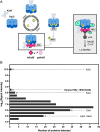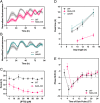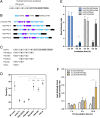KidA, a multi-PAS domain protein, tunes the period of the cyanobacterial circadian oscillator
- PMID: 36067319
- PMCID: PMC9478674
- DOI: 10.1073/pnas.2202426119
KidA, a multi-PAS domain protein, tunes the period of the cyanobacterial circadian oscillator
Abstract
The cyanobacterial clock presents a unique opportunity to understand the biochemical basis of circadian rhythms. The core oscillator, composed of the KaiA, KaiB, and KaiC proteins, has been extensively studied, but a complete picture of its connection to the physiology of the cell is lacking. To identify previously unknown components of the clock, we used KaiB locked in its active fold as bait in an immunoprecipitation/mass spectrometry approach. We found that the most abundant interactor, other than KaiC, was a putative diguanylate cyclase protein predicted to contain multiple Per-Arnt-Sim (PAS) domains, which we propose to name KidA. Here we show that KidA directly binds to the fold-switched active form of KaiB through its N-terminal PAS domains. We found that KidA shortens the period of the circadian clock both in vivo and in vitro and alters the ability of the clock to entrain to light-dark cycles. The dose-dependent effect of KidA on the clock period could be quantitatively recapitulated by a mathematical model in which KidA stabilizes the fold-switched form of KaiB, favoring rebinding to KaiC. Put together, our results show that the period and amplitude of the clock can be modulated by regulating the access of KaiB to the fold-switched form.
Keywords: circadian rhythms; cyanobacteria; diguanylate cyclase.
Conflict of interest statement
The authors declare no competing interest.
Figures




Similar articles
-
Circadian rhythms. A protein fold switch joins the circadian oscillator to clock output in cyanobacteria.Science. 2015 Jul 17;349(6245):324-8. doi: 10.1126/science.1260031. Epub 2015 Jun 25. Science. 2015. PMID: 26113641 Free PMC article.
-
Cooperative Binding of KaiB to the KaiC Hexamer Ensures Accurate Circadian Clock Oscillation in Cyanobacteria.Int J Mol Sci. 2019 Sep 13;20(18):4550. doi: 10.3390/ijms20184550. Int J Mol Sci. 2019. PMID: 31540310 Free PMC article.
-
Structural characterization of the circadian clock protein complex composed of KaiB and KaiC by inverse contrast-matching small-angle neutron scattering.Sci Rep. 2016 Oct 18;6:35567. doi: 10.1038/srep35567. Sci Rep. 2016. PMID: 27752127 Free PMC article.
-
A cyanobacterial circadian clock based on the Kai oscillator.Cold Spring Harb Symp Quant Biol. 2007;72:47-55. doi: 10.1101/sqb.2007.72.029. Cold Spring Harb Symp Quant Biol. 2007. PMID: 18419262 Review.
-
Diversity of KaiC-based timing systems in marine Cyanobacteria.Mar Genomics. 2014 Apr;14:3-16. doi: 10.1016/j.margen.2013.12.006. Epub 2014 Jan 3. Mar Genomics. 2014. PMID: 24388874 Review.
Cited by
-
The inner workings of an ancient biological clock.Trends Biochem Sci. 2024 Mar;49(3):236-246. doi: 10.1016/j.tibs.2023.12.007. Epub 2024 Jan 6. Trends Biochem Sci. 2024. PMID: 38185606 Free PMC article. Review.
-
When lowering temperature, the in vivo circadian clock in cyanobacteria follows and surpasses the in vitro protein clock trough the Hopf bifurcation.Sci Rep. 2025 Apr 28;15(1):14884. doi: 10.1038/s41598-025-97412-6. Sci Rep. 2025. PMID: 40295582 Free PMC article.
-
Temperature-dependent fold-switching mechanism of the circadian clock protein KaiB.Proc Natl Acad Sci U S A. 2024 Dec 17;121(51):e2412327121. doi: 10.1073/pnas.2412327121. Epub 2024 Dec 13. Proc Natl Acad Sci U S A. 2024. PMID: 39671178 Free PMC article.
-
Synchronization of the circadian clock to the environment tracked in real time.Proc Natl Acad Sci U S A. 2023 Mar 28;120(13):e2221453120. doi: 10.1073/pnas.2221453120. Epub 2023 Mar 20. Proc Natl Acad Sci U S A. 2023. PMID: 36940340 Free PMC article.
References
-
- Nakajima M., et al. , Reconstitution of circadian oscillation of cyanobacterial KaiC phosphorylation in vitro. Science 308, 414–415 (2005). - PubMed
Publication types
MeSH terms
Substances
Supplementary concepts
Grants and funding
LinkOut - more resources
Full Text Sources

